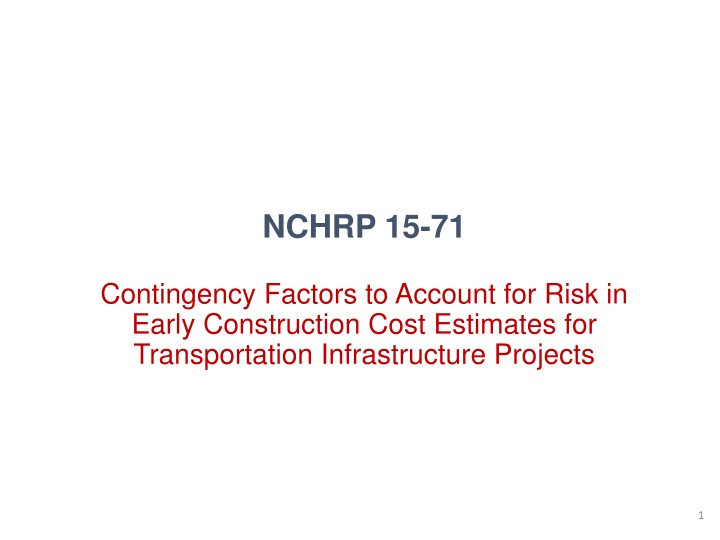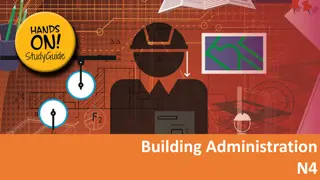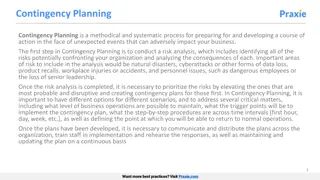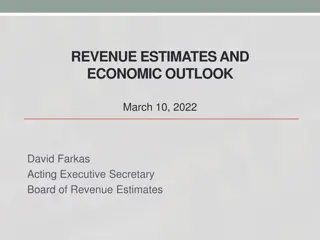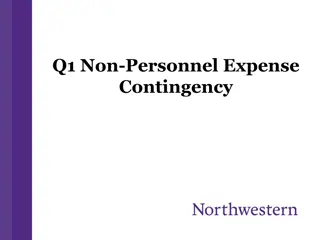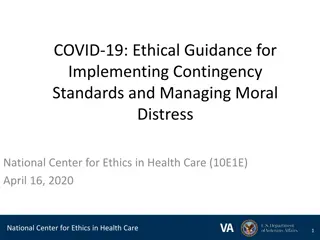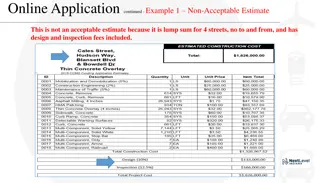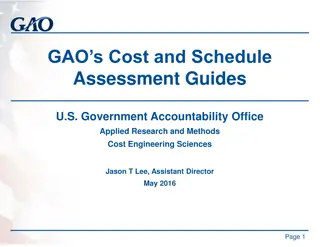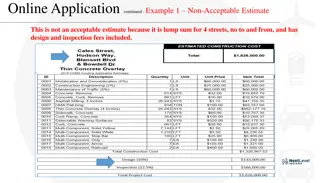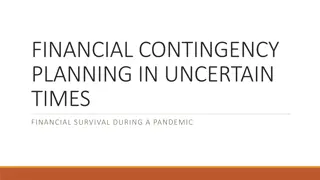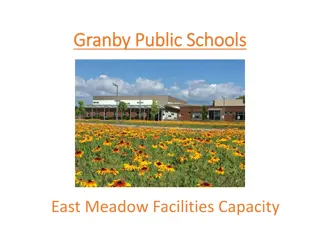Contingency Factors in Construction Cost Estimates
This research project focuses on identifying and analyzing risk factors in early construction cost estimates for transportation projects. The goal is to develop a standardized approach for incorporating project-related risks into estimates, including defining contingency factor ranges for high-priority risks.
Download Presentation

Please find below an Image/Link to download the presentation.
The content on the website is provided AS IS for your information and personal use only. It may not be sold, licensed, or shared on other websites without obtaining consent from the author.If you encounter any issues during the download, it is possible that the publisher has removed the file from their server.
You are allowed to download the files provided on this website for personal or commercial use, subject to the condition that they are used lawfully. All files are the property of their respective owners.
The content on the website is provided AS IS for your information and personal use only. It may not be sold, licensed, or shared on other websites without obtaining consent from the author.
E N D
Presentation Transcript
NCHRP 15-71 Contingency Factors to Account for Risk in Early Construction Cost Estimates for Transportation Infrastructure Projects 1
1. Introduction Research Goal This research project aims to identify, analyze, and understand the risk factors associated with the accuracy of early construction cost estimates and develop a standardized approach to accounting for project-related risks in early construction cost estimates, including the determination of contingency factor ranges for at least eight high-priority risks. 2
Guidebook Structure 1. 2. 3. 4. 5. Introduction Key Concepts Construction Contingencies Estimation Methods for Construction Contingencies Major Risks for Construction Contingency Consideration Guidance on Risk-Driven Approach for Estimating Construction Contingencies Guidance on Historical Data-Driven Approach for Estimating Construction Contingencies Guidance on Tracking and Monitoring Construction Contingencies 6. 7. 3
2. Key Concepts Construction Contingencies Major Elements of Construction Cost Estimate Contingency for Unknown Knowns Early Estimate = Base cost (itemized costs + allowance) + Contingency 4
3. Estimation Methods for Construction Contingencies Construction Contingency Estimating Contingency estimating methods Deterministic approach - Determine a single point estimate. - Appropriate when estimators are familiar Deterministic approach Probabilistic approach with the type of the project from their experience. Fixed percentage Expected value Probabilistic approach Monte-Carlo simulation Sliding scale - Modeling uncertainty through statistical Expert judgment PERT techniques. Parametric estimating - Quantify risk impacts of probability with given project information. 5
3. Estimation Methods for Construction Contingencies Deterministic approach Fixed percentage of base cost Sliding Scale Expert Judgment - The simplest method. - A pre-determined percentage of the base cost. - A range of percentages. - Different ranges for different project conditions - Use estimator s personal experience and judgement. - Reflect project specific characteristics. Project development stage Feasibility Functional Preliminary At ROW Final preliminary Contingency for roadway portion +55% +45% +35% +25% +15% Contingency for structure portion +15% +15% +10% +10% +5% Define decision problems Recruit experts Collect expert judgement Analyze expert judgement (Pros) Simple, straightforward, and available when useful project information is insufficient. (Cons) Accuracy is dependent upon cost estimator s experience and expertise. 6
3. Estimation Methods for Construction Contingencies Probabilistic approach Expected value Occurrence (%) (A) Impacts ($) (B) Contingency ($) (A)*(B) Risks Known Hazardous Substance 10 125,000 12,500 - Identify project-specific risks and evaluate the probability and impact of the identified risks. - Require detail project information. Coordination with Railroad Agencies Treatment of Water Discharged from Site Total 10 50,000 5,000 3 400,000 12,000 29,500 Monte Carlo simulation - A sophisticated computer-based probabilistic method. - Provide more realistic contingencies through a range of possible values. (Pros) Can reflect project-specific characteristics and conduct more flexible contingency estimates. (Cons) Requires more time and effort to perform it.
4. Major Risks for Construction Contingency Consideration Major Risks for Construction Contingency Estimating Top risk identification process 1. Analysis of DOT risk checklists and risk registers 2. Find risks through discussions with DOTs 3. Assess risk occurrences and impact magnitude 4. Prioritize top 12 risks The list of 23 risks Determined top 12 risks 8
4. Major Risks for Construction Contingency Consideration Top 12 Major Risks 23 risks for contingency estimating Prioritized Top 12 risks Utility issues Unexpected geotechnical issues Constructability issues Railroad involvement Late changes requested by stakeholders Errors in cost estimating Maintenance of traffic/work zone traffic control Unknown or change in current asset conditions Unexpected archeological or historic findings Endangered/protected species encountered during construction Issues with new materials, technologies, and methods Coordination with other projects Poor or incomplete project scope definition during the scoping phase Design changes Contractor availability and competition Market conditions Project duration-related issues Funding availability Hazardous materials encountered during construction Coordination with government agencies Surveys late or in error Political risks Unanticipated noise impacts and noise mitigation Ranking Risk 1 Utility issues Poor or incomplete project scope definition during the scoping phase 2 3 4 5 6 7 8 9 10 11 12 Unexpected geotechnical issues Design changes Constructability issues Contractor availability and competition Railroad involvement Market conditions Late changes requested by stakeholders Project duration-related issues Errors in cost estimating Funding availability 9
5. Guidance on Risk-Driven Approach for Estimating Construction Contingencies Workflow of Estimating Contingency for High Priority risks 1. Determine project characteristics, conditions, and environments No Is there any trigger? Stop Yes 3. Conduct qualitative assessment 2. Contact subject matter experts (SMEs) No Is this risk significant? Stop Help more thorough and comprehensive Yes 4. Gather information & data from SMEs risk considerations. Can reflect project characteristics rather 5. Determine the probability and cost impact of the risk than simply apply pre-defined 6. (Optional) Select a response strategy & determine residual contingency percentages Output the contingency amount for the risk 10
5. Guidance on Risk-Driven Approach for Estimating Construction Contingencies Step 1 1. Determine project characteristics, conditions, and environments No Is there any trigger? Stop Yes 3. Conduct qualitative assessment 2. Contact subject matter experts (SMEs) No Is this risk significant? Stop Step 1:Determine project characteristics, conditions, and environments Yes 4. Gather information & data from SMEs - Gather key project information from 5. Determine the probability and cost impact of the risk scoping reports, including characteristics, conditions, and environments. 6. (Optional) Select a response strategy & determine residual contingency - Identify the triggers for each of the top risks. Output the contingency amount for the risk
5. Guidance on Risk-Driven Approach for Estimating Construction Contingencies Step 2 1. Determine project characteristics, conditions, and environments No Is there any trigger? Stop Yes 3. Conduct qualitative assessment 2. Contact subject matter experts (SMEs) No Is this risk significant? Stop Step 2: Contact subject matter experts (SMEs) Yes 4. Gather information & data from SMEs - SMEs can provide valuable input and 5. Determine the probability and cost impact of the risk help validate project cost estimates. - Early cost estimators can contact 6. (Optional) Select a response strategy & determine residual contingency relevant SMEs to get more information on the risks. Output the contingency amount for the risk 12
5. Guidance on Risk-Driven Approach for Estimating Construction Contingencies Step 3 1. Determine project characteristics, conditions, and environments No Is there any trigger? Stop Yes 3. Conduct qualitative assessment 2. Contact subject matter experts (SMEs) No Is this risk significant? Stop Step 3:Conduct qualitative assessment Yes 4. Gather information & data from SMEs - Evaluate the risk s significance on the project. 5. Determine the probability and cost impact of the risk - Assign scores from 1 to 5 to the risks 6. (Optional) Select a response strategy & determine residual contingency in terms of occurrence probability and their impacts. Output the contingency amount for the risk 13
5. Guidance on Risk-Driven Approach for Estimating Construction Contingencies Step 4 1. Determine project characteristics, conditions, and environments No Is there any trigger? Stop Yes 3. Conduct qualitative assessment 2. Contact subject matter experts (SMEs) No Is this risk significant? Stop Step 4:Gather information & data from SMEs Yes 4. Gather information & data from SMEs - Gather information and data from 5. Determine the probability and cost impact of the risk SMEs that can serve as a reference for early cost estimators. 6. (Optional) Select a response strategy & determine residual contingency Output the contingency amount for the risk 14
5. Guidance on Risk-Driven Approach for Estimating Construction Contingencies Step 5 and Step 6 1. Determine project characteristics, conditions, and environments No Is there any trigger? Stop Yes 3. Conduct qualitative assessment 2. Contact subject matter experts (SMEs) No Step 5:Determine the probability and cost impact of the risks Is this risk significant? Stop Yes - Estimate the risk s impact (optimistic (O), 4. Gather information & data from SMEs most likely (M), and pessimistic (P)). 5. Determine the probability and cost impact of the risk - The average impact: I = (O+4M+P)/6. - Contingency amount = Pr x I 6. (Optional) Select a response strategy & determine residual contingency Step 6:(Optional) Select a response strategy & determine residual contingency Output the contingency amount for the risk 15
5. Guidance on Risk-Driven Approach for Estimating Construction Contingencies MS Excel Tool for Risk-Driven Contingency Estimating Early Risk-Driven Estimating and Monitoring of Construction Cost Contingencies (EReC3) EReC3_Risk list (Scoping phase) Early Risk-Driven Estimating and Monitoring of Construction Cost Contingencies (EReC3) Please select the risks you would like to consider in your estimation using the last column of below table. If you are not sure, please consider them all at this stage. Below figure provides the general step-by-step process of evaluating each selected risk. Please click blue box to move to the next step or back to the previous step. Instruction: EReC3 is designed to help DOTs' early cost estimators to effectively estimate construction cost contingencies for top priority risks. - Select three steps of risk-driven construction contingency estimating if you are to figure out details of these steps. - Select blue boxes if you are to move to risk measurement points. Top construction cost contingency risks Risk-driven construction contingency estimating process Clear up ID. Description Considered? Click the left figure. Risk Investiagtion R01 R02 Utility issues (e.g., utility conflicts, and utility relocation of identified utilities) Poor or incomplete project scope definition during the scoping phase Unexpected geotechnical issues (e.g., inadequate geotechnical investigation results, poor soil conditions, unsound subgrade conditions, large boulders contained in existing soils, or adverse groundwater conditions) Design changes (e.g., changes in the bridge foundation type or redesign of the drainage facility, changes in design standards, exceptions to design standards, and inaccurate design assumptions) Constructability issues (e.g., problems with construction sequencing/staging/phasing) Contractor availability and competition (e.g., lack of competition due to project size) Railroad involvement (e.g., additional requirements due to proximity to the railroad) Market conditions (e.g., a shortage of local contractors, labor, and material) Yes Yes Qualitative Assessment R03 Yes Quantitative Assessment R04 Yes R05 R06 R07 R08 Yes Yes Yes Yes Contingency tracking & monitoring R09 Late changes requested by stakeholders Yes Project duration-related issues (e.g., scheduling errors, inaccurate contract time estimates, restricted working windows for some activities, or issues with aggressive schedules) R10 Yes R11 R12 Errors in cost estimating Funding availability Yes Yes Note: Click blue boxes for movement: Grey cells:Automated Warning: For the toolkit to work properly, please make sure you click on "Enable Content/Macros" if the security warning appears. "Home" sheet Risk list-up" sheet 16
5. Guidance on Risk-Driven Approach for Estimating Construction Contingencies Specific sheets of EReC3 QUALITATIVE RISK ASSESSMENT (SCOPING PHASE) RISK IDENTIFICATION (SCOPING PHASE) Specific contact for this project Likelihood (1-5) Impact (1-5) Significant ? Risk matrix Are there any triggers in this project? What are the triggers in this project? ID. Typical Subject Matter Experts (SMEs) to contact Risk score ID. Risk factor Common triggers for checking Action 5 4 3 2 1 Likelihood X Local area ROW personnel Maintenance personnel that have worked in the area for an extended amount of time Utility managers Jane Done, Geotechnical engineer Proximity to urban centers Rocky or variable subsurface conditions No recent major roadwork within the alignment R01 4 5 20 Yes Utility issues (e.g., utility conflicts, and utility relocation of identified utilities) Proximity to urban centers R01 Yes Continue 1 2 3 4 5 Impact 5 4 3 2 1 Likelihood X Professional engineers or architects representing the stakeholders interests DOT s functional groups Sandie Angulo Chen, Project engineer R02 3 4 12 Yes Poor or incomplete project scope definition during the scoping phase R02 Yes Continue Many stakeholders involved in the project 1 2 3 4 5 Impact 5 4 3 2 1 Unexpected geotechnical issues (e.g., inadequate geotechnical investigation results, poor soil conditions, unsound subgrade conditions, large boulders contained in existing soils, or adverse groundwater conditions) Likelihood X Geotechnical engineers Maintenance office Previous contractors in the area USDA Extension agents regarding water levels Robert Garcia, Project Engineering Designer Variability of subsurface conditions Known geotechnical issues in the area Inadequate geotechnical investigations Unknown groundwater flow direction R03 4 4 16 Yes R03 Yes Continue 1 2 3 4 5 Impact 5 4 3 2 1 Lack of surveys and field reviews New materials or technologies (e.g., channel stabilization) used in the project Lack of communications between the project team, designers, and stakeholders Long planning and scoping process Likelihood Design changes (e.g., changes in the bridge foundation type or redesign of the drainage facility, changes in design standards, exceptions to design standards, and inaccurate design assumptions) X Area engineers and area maintenance staff Designers Functional groups David Martinez, Maintenance Office, District 1 R04 3 4 12 Yes R04 Yes Continue 1 2 3 4 5 Impact Sheet 1: Risk identification Sheet 2: Qualitative risk assessment Note: Grey cells: Automated RISK RESPONSE (SCOPING PHASE) QUANTITATIVE RISK ASSESSMENT (SCOPING PHASE) Quantitative Risk Assessment Residual Risk Assessment Risk Impact ($) from the data and information obtained Cost estimator's calculation Risk response Contingency after risk response Information & data typically obtained from SMEs Specific details for this project ID. Risk factor Impact on construction cost Probable impact Probability of occurrence Minimum Most likely Maximum Expective value ID. Risk control method Probability of occurrence after risk response Construction cost impact of the action Responsibility Action to control risk Expective value Utility cost information for recent projects with similar scope in the same general area Utility issues (e.g., utility conflicts, discovery of previously unknown utilities, and utility relocation) R01 370,000.00 $ 420,000.00 $ 490,000.00 $ 423,333.33 $ $ 423,333 85% 359,833.33 $ Subsurface Utility Engineering (SUE) Survey Clarifications from functional groups for unclear requirements Alternative analyses such as pavement analysis and life cycle analysis Local/federal policies with possible ripple effects on project requirements Scoping reports from past similar projects in the area Existing geotechnical reports, lab tests, and test borings As-built plans and maintenance records Production rate information for different subsurface conditions (e.g., equipment manufacturers published rates) Cost data (e.g., loading and trucking cost if off-site material is R01 Transfer Utility Engineer $ 14,000.00 75% $ 317,500.00 Poor or incomplete project scope definition during the scoping phase R02 80,000.00 $ 140,000.00 $ 180,000.00 $ 136,666.67 $ 136,666.67 $ 90% 123,000.00 $ Unexpected geotechnical issues (e.g., inadequate geotechnical investigation results, poor soil conditions, unsound subgrade conditions, large boulders contained in existing soils, or adverse groundwater conditions) Subsurface Utility Engineering (SUE) Survey R02 Accept Project Engineer $ 4,500.00 82% $ 112,066.67 R03 100,000.00 $ 145,000.00 $ 185,000.00 $ 144,166.67 $ 144,166.67 $ 85% 122,541.67 $ Sheet 3: Quantitative risk assessment Sheet 4: Risk mitigation 17
6. Guidance on Historical Data-Driven Approach for Estimating Construction Contingencies Overall Process of Historical Data-Driven Approach 2. Data Cleaning and Pre- processing 3. Data Analysis and Project Characterization 1. Historical Cost Data Collection 4. Model Development 5. Apply Model to Projects - Use historical digital data for performing a construction contingency estimation. - Allow cost estimators to have confidence in their contingency numbers for a new project. 18
6. Guidance on Historical Data-Driven Approach for Estimating Construction Contingencies Work Tasks for Historical Data-Driven Approach 2. Data Cleaning and Pre- processing 3. Data Analysis and Project Characterization 1. Historical Cost Data Collection 4. Model Development 5. Apply Model to Projects <Cost data for data collection> Data collection and cleaning Cost type Ideal data attributes Base estimate (major work items + allowance) Construction contingency The entire list of pay items with their quantities and unit prices The entire list of actual pay items with their quantities and unit prices Change orders - Gather historical data over the Early estimate project development phases. - Filter out projects that went Engineer s estimate through major scope changes. Final construction cost 19
6. Guidance on Historical Data-Driven Approach for Estimating Construction Contingencies Work Tasks for Historical Data-Driven Approach 2. Data Cleaning and Pre- processing 3. Data Analysis and Project Characterization 1. Historical Cost Data Collection 4. Model Development 5. Apply Model to Projects RFB: The ratio of the final construction cost to the base cost estimate ??? (%) = (????? ???????????? ???? ?? ? ? ??? ?? ??????? ???? ???? ???????? ?? ? ? ??????? ? ??? 1) ? 100 Classify project based on characteristics Ex) Project type: New construction, Reconstruction, Resurfacing, Rehabilitation, and Relocation. Project size: Small sized, Mid sized, and Large sized. 20
6. Guidance on Historical Data-Driven Approach for Estimating Construction Contingencies Work Tasks for Historical Data-Driven Approach 2. Data Cleaning and Pre- processing 3. Data Analysis and Project Characterization 1. Historical Cost Data Collection 4. Model Development 5. Apply Model to Projects Contingency range estimation - Perform statistical analysis. - Probability distribution fitting. <PDF> - Develop probability density functions (PDF) and cumulative distribution functions (CDF). <CDF> 21
6. Guidance on Historical Data-Driven Approach for Estimating Construction Contingencies Case Study - Demonstrate the process with real data. - Use DOT s actual historical data for in-depth case study - Offer a practical idea on how the results can be assessed for a more defensible construction contingency estimation. <Project types for case study> Project types Number of projects Roadway - new construction Roadway - reconstruction Roadway resurfacing Roadway - rehabilitation Roadway replacement Bridge new construction Bridge replacement Bridge rehabilitation Total 112 76 338 90 15 6 50 52 739 22
6. Guidance on Historical Data-Driven Approach for Estimating Construction Contingencies Case Study - CDFs of six project types. - Cumulative probability refers to certainty about a given RFB. - RFB can be a percentage of base cost. RFB 30% Types 10% 50% Roadway - new construction 0.022 0.638 0.93 0.177 Roadway reconstruction 0.688 0.905 0.697 0.966 Roadway resurfacing 0.101 Roadway rehabilitation 0.132 0.652 0.888 Bridge replacement 0.136 0.677 0.928 Bridge rehabilitation 0.091 0.670 0.927 23
6. Guidance on Historical Data-Driven Approach for Estimating Construction Contingencies Case Study Applications (Incorporate CDF into sliding scales) : Convert a construction contingency amount to the percentage of the base estimate. : Check cumulative probability from CDF curves to ensure the certainty of construction contingency. 24
6. Guidance on Historical Data-Driven Approach for Estimating Construction Contingencies Use of Two approaches RISK RESPONSE (SCOPING PHASE) Residual Risk Assessment Risk response Contingency after risk response ID. Risk control method Probability of occurrence after risk response Construction cost impact of the action Responsibility Action to control risk Expective value Subsurface Utility Engineering (SUE) Survey R01 Transfer Utility Engineer $ 14,000.00 75% $ 317,500.00 Subsurface Utility Engineering (SUE) Survey R02 Accept Project Engineer $ 4,500.00 82% $ 112,066.67 Verification: Historical data-driven approach Estimation: Risk-driven approach - Conduct risk identification and - Backcheck the amounts from risk- estimate their impacts on driven estimating. construction contingency. - Evaluate certainty for verification. 25
7. Guidance on Tracking and Monitoring Construction Contingencies Construction Contingencies Tracking and Monitoring Major milestone meetings for tracking and monitoring (a) (b) (c) (d) (e) End of project scoping Construction completion 30% design 60% design 90% design 26
7. Guidance on Tracking and Monitoring Construction Contingencies Iterative Process for Tracking and Monitoring Construction Contingencies Construction contingency monitoring and tracking Scoping 30% design 60% design 90% design End of construction Before risk response After risk response Before risk response After risk response Before risk response After risk response Before risk response After risk response Actual paid amounts R01 R02 R03 R04 R05 R06 R07 R08 R09 R10 R11 R12 150,000 20,000 50,000 200,000 10,000 359,833 123,000 122,542 123,750 103,133 210,750 84,858 30,000 20,000 24,000 19,200 20,800 317,500 112,067 116,775 116,875 92,213 187,333 79,867 30,000 20,000 22,000 18,000 20,000 304,800 102,500 111,008 104,500 84,933 175,625 71,880 28,800 20,000 20,000 17,200 18,000 296,333 102,500 100,917 96,250 80,080 168,600 69,883 26,000 18,800 18,000 16,000 16,000 254,000 88,833 89,383 85,250 72,800 152,208 64,892 24,000 16,000 16,000 16,000 14,800 254,000 82,000 86,500 82,500 72,800 140,500 57,903 23,200 14,800 14,800 14,000 14,000 190,500 65,600 74,967 70,125 60,667 124,108 50,915 22,000 14,000 14,000 12,000 12,800 169,333 61,500 69,200 59,125 50,960 117,083 47,920 20,000 12,800 12,800 12,000 12,000 2,501 8,000 12,000 11,000 10,000 9,000 8,000 1400000 1200000 1000000 800000 600000 400000 200000 0 Before response After response Before response After response Before response After response Before response After response Actual paid amounts . Scoping 30% design 60% design 90% design End of construction R01 R02 R03 R04 R05 R06 R07 R08 R09 R10 R11 R12 <MS Excel tool interface for contingency tracking and monitoring> 27
7. Guidance on Tracking and Monitoring Construction Contingencies Construction contingency monitoring metrics Metrics during design Metrics during construction Quantity growth Quantity growth Quantity growth due to Change Orders Schedule growth Change order cost growth Contingency growth Change Order schedule growth Risk retirement rate Risk retirement rate Contingency consumption rate Contingency consumption rate Value engineering savings rate Value engineering savings rate 28
7. Guidance on Tracking and Monitoring Construction Contingencies Continuous Improvement of Construction Contingency Estimating Process <Process for feedback loop for construction contingency estimating> 29
Thank you This presentation highlights the key findings of NCHRP Project 15-71: Contingency Factors to Account for Risk in Early Construction Cost Estimates for Transportation Infrastructure Projects. More information is available in NCHRP Research Report 1025:Contingency Factors to Account for Risk in Early Construction Cost Estimates for Transportation Infrastructure, which can be obtained from the National Academies press website (www.nap.edu). The National Cooperative Highway Research Program (NCHRP) is sponsored by the individual state departments of transportation of the American Association of State Highway and Transportation Officials. NCHRP is administered by the Transportation Research Board (TRB), part of the National Academies of Sciences, Engineering, and Medicine, under a cooperative agreement with the Federal Highway Administration (FHWA). Any opinions and conclusions expressed or implied in resulting research products are those of the individuals and organizations who performed the research and are not necessarily those of TRB; the National Academies of Sciences, Engineering, and Medicine; the FHWA; or NCHRP sponsors. 30
